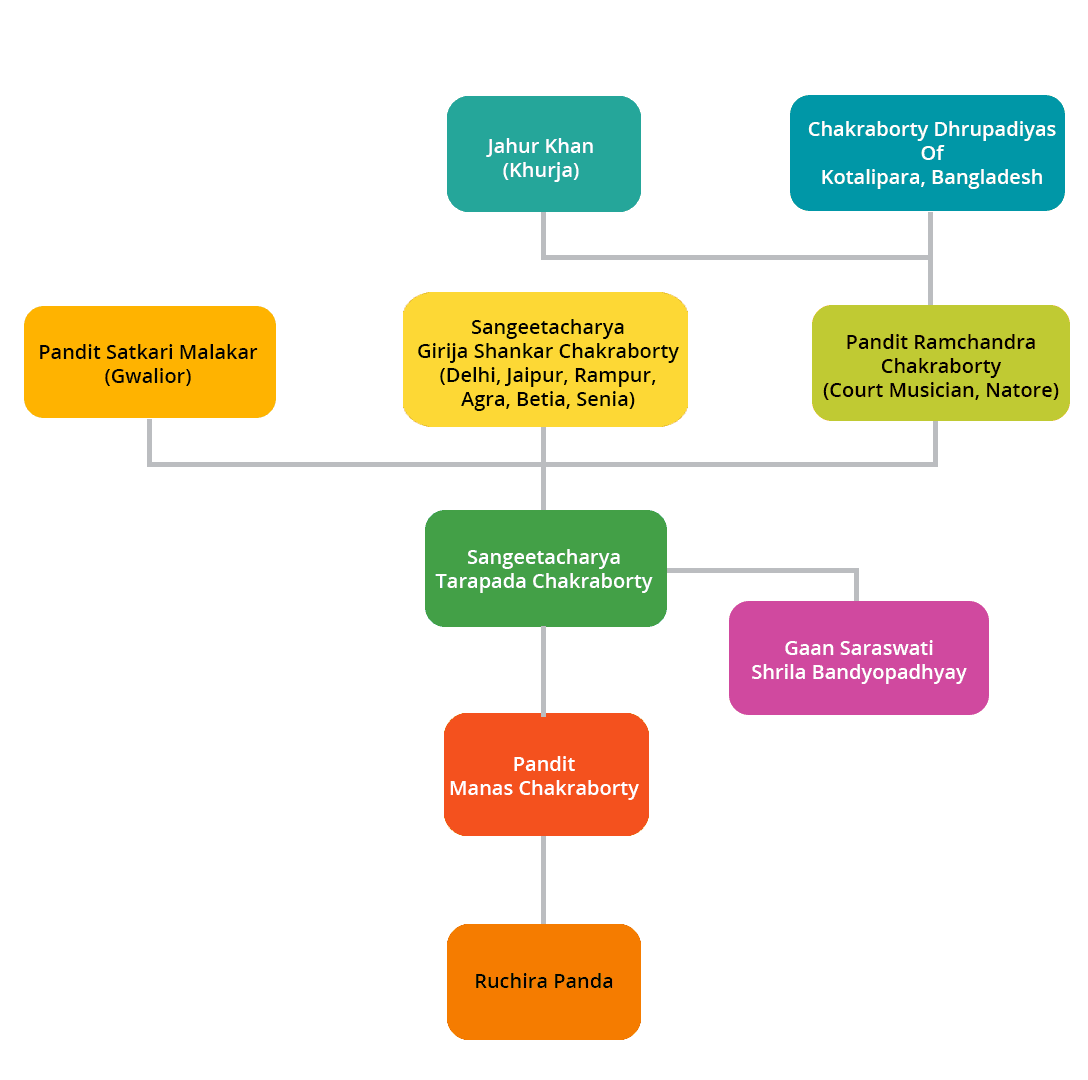Kotali Gharana

…Sangeetacharya Tarapada Chakraborty (1909-1975), was the first Pan-Indian Khayaliya from Bengal. The Sangeetacharya who was named The Bengal Tiger of Indian Classical by Baba Alauddin Khan for his extraordinary talent and grit.
He had a journey similar to Ustad Allauddin Khan’s, coming to Kolkata penniless from Kotalipara ( currently in Bangladesh ) to learn classical music.
He came from a family of eminent Dhrupadiyas. His great-grandfather Pandit Biswambhar Chakraborty was initiated to Seni Gharana. His father, Pandit Kulachandra Chakraborty and his uncle Pandit Ramchandra Chakraborty had their training from Ustad Jahur Khan of Khurja Gharana – starting the move towards Khayal. Ramchandra had the honor of being the Dwarpandit (court scholar) and the court musician of the Maharaja of Natore.
Tarapada was very young when he landed in the big city, in search of a Khayal guru, sleeping on the sidewalks, and staving off eviction by the “Gora” policeman by singing a song or two.
The Sangeetacharya first learned from the visually challenged maestro, Pandit Satkari Malakar of Gwalior gharana, who eventually kicked the boy out when it was found that the young student was an incredibly “shrutidhar” child prodigy, being able to remember and reproduce long Khayal passages and taans heard just once and learning all the rare “cheez” of his like a sponge. Teachers used to be very parsimonious in this regard in those days.
Tarapada then went to the famous teacher and Zamindar Sangeetacharya Girija Shankar Chakrabarty. Girija Shankar used to host Ustads and Pandits, paid them handsomely, sometimes even whole villages. He thus accumulated an enviable collection of Bandishes and the talim from Betia, Agra, Rampur, Gwalior, Jaipur, Bishnupur, Kirana and other gharanas.
A spectacular memory and a mellifluous voice allowed the young Tarapada to imbibe the features and compositions of these gharanas, and he would learn to sing in a different style in different concerts. Sometimes his students would taunt him that Bade Ghulam Ali Khan would be singing after him in a conference – and he would then sing for two hours in pure Patiyala style.
GirijaShankar also had an enviable collection of Thumris, and thus the emphasis of the Purav-ang Thumri in the Kotali repertoire, was born.
Tarapada Chakraborty, was interestingly, also a gifted and ‘layadar’ Tabla player. He started his career as a Tabla player with All India Radio, accompanying Ustad Enayet Khan, Ustad Alauddin Khan, Ustad Hafiz Ali Khan and others. In one of the Radio programs the vocalist did not come, and Tarapada was asked to sing.
There was no looking back after that. Interestingly even when he was at his peak as a vocalist, sometimes Ustads and Pandits would specifically request for “Dada” to accompany them on Tabla
Sangeetacharya Tarapada Chakraborty is credited with the current format of 48-beat (4×12) Ati-Vilambit (extra-slow-tempo) Ektaal Khyal format, with Ustad Karamatullah Khan ( who accompanied both him and his son, Pandit Manas Chakraborty on many occasions) fixing the theka, which led Ustad Amir Khan to create the 56 beat (4×14) Jhoomra Khayal. He is also credited with the propagation of Bengali RaagPradhan and Bengali Thumri sub-genres.
The Raga ChhayaHindol is his creation – which is a stunningly different vision on a Hindol base ( it is not an amalgamation of Chhaya and Hindol ). A 20+ minute Youtube video exists. Ustad Ali Akbar Khan, a family friend, created Hem Hindol afterwards.
Despite the age difference, he was a close friend of Ustad Allauddin Khan (who used to call him “KottaMoshai” – kind of “BabuMoshai” ) and Ustad Faiyaz Khan. Existing letters between them are a fun read, and reflect the deep respect and affection that existed between eminent musicians in those days. Faiyaz Khan once put him in the top three khayaliyas of India.
He was awarded the Sangeet Natak Akademi Fellowship the highest honour conferred by Sangeet Natak Akademi, India’s National Academy for Music, Dance and Drama. [4] He was the recipient of State Academy Award from Rabindra Bharati University in 1972.
He was proud of his craft and very unassuming. In his frail years, when India’s civilian honor Padma Shri was finally sent to him in 1974 by the Government, he famously chased the messenger away from his Kolkata home, considering it to be far below his status.
It has been India’s misfortunate that almost all of his All India Radio Recordings of Khayal are now lost due to negligence ( conspiracy theories abound in this context – because he was unique , and the envy of many ). Some live recordings have been recovered by researchers during the year-long birth centenary celebration in 2009, organized by PARAMPARIK and the West Bengal Government. [ Excerpted ]